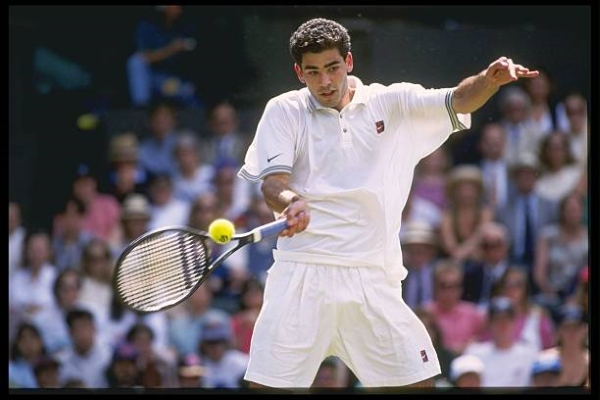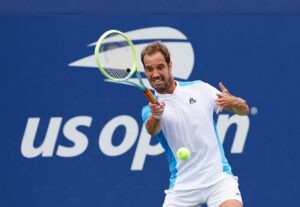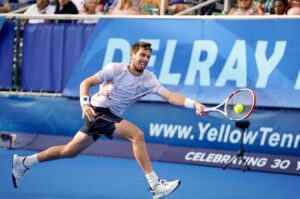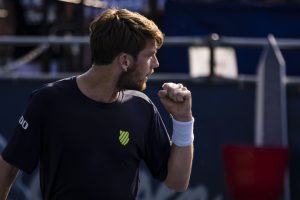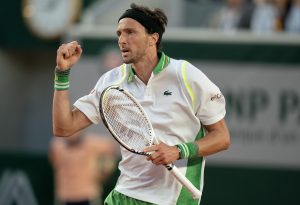The 1994 Wimbledon final between Pete Sampras and Goran Ivanisevic took place on an unusually hot July day in London. Beforehand, everybody knew the rallies would be short and points quick. However, no one would have predicted the importance this match would play in the direction of modern tennis.
The match was won by Sampras in straight sets with a strange score line of 7-6 7-6 6-0. After Ivanisevic lost two tiebreaks, he crumbled in the third set. He looked helpless as Sampras pulled out an array of returns and passing shots. However, what seemed to get the media going was how the match unfolded. Essentially a series of strong serves, aces, mishit returns or returns into the net on an incredibly regular basis.
With the temperature around 30 degrees centigrade and the ball flying as a result, there were nil rallies as a consequence. Ivanisevic hit 25 aces and Sampras 17, whilst many of Sampras’ serves were consistently around 210kph (130mph). Due to the very hot weather and the potency of the serves, the ball flew like missiles as each player added topspin at pace, making balls extremely difficult to return.
There were serve-and-volley festivals before on finals day. In 1991 Michael Stich defeated Boris Becker, while Stefan Edberg played Becker in three straight finals between 1988 and 1990. In 1986 and 1987, Ivan Lendl impersonated a serve-volleyer but lost to Becker and Pat Cash respectively. And in 1985, a 17 year old Becker defeated big serving Kevin Curren.
However, what made this match different was each player’s ability to hit their second serves as good as first serves. In the past the crowd knew they were going to get some action on the second ball with great tennis. This time many second serves went the way a first serve would – ace, mishit return or return into the net. After the final Sampras, interviewed by BBC’s Sue Barker protested this was grass court tennis. He claimed clay tennis could have matches where rallies were too long. Plus he stayed with the same racquet technology and not adopted a wide body frame like many of his opponents.
The negative clamour by the media about this final was pretty huge. The game was too quick and serve dominated they cried, which in turn was killing tennis. Of course, in 1994 there were no forums, Facebook or twitter where fans could make their voices heard immediately. But the message by the media (voice of the people) was clear, this was not the tennis the public wanted to see. The interesting thing was, watching a re-run of the video, the crowd seemed pretty into it, or maybe that was just the tiebreaks.
Looking back, not only was this the beginning of the end of fast grass at Wimbledon. It was also the beginning of the end of fast courts in professional tennis. The changes were first manifested for 1995 Wimbledon. The committee sanctioned a slower “softer” ball before the tournament, designed to introduce more rallies. Further changes would take place over subsequent years. This included changes to the composition and the cut of the grass and further alterations to the Slazenger ball. This did not stop a big server winning the tournament between 1994 and 2001. Sampras won in 1995, 1997, 1998, 1999 and 2000, whilst Richard Krajicek triumphing in 1996 and Goran Ivanisevic in 2001.
Changes made over time on grass did not become apparent until 2002. Mainly due to the big servers of the 1990s slowing down or retiring outright. Krajicek got to the quarterfinal as a wildcard but lost in five sets to Xavier Malisse. Whilst in the semifinal Tim Henman got comprehensively outplayed by Lleyton Hewitt. Hewitt played David Nalbandian in the final, the first all baseline final since the 1970s. Unlike Borg v Connors who ventured to net as often as possible, these guys only went to net to shake hands.
Serve & volley on both serves on grass became an ideology during this era. It became a way of playing not absolutely necessary but there was a degree of obsession to do it. By the 1990s grass courts were more than good enough to aid baseline play. In fact, between 1990 and 1999, baseliners played in five of the ten finals. Andre Agassi won the title in 1992 and played in the 1999 final. Jim Courier played in the 1993 final, MaliVai Washington in 1996 and Cedric Pioline in 1997.
To see how serve-volley on both serves became a philosophy on grass only, just three months beforehand, Sampras played Agassi in the Miami final. On a slow hard court, Sampras came from a set down to win 5-7 6-3 6-3. During the match, Sampras stayed back on his second serve throughout and on first serve on occasion. The outcome was an extremely enjoyable match full of great baseline rallies No doubt these were the kind of matches the Wimbledon committee wanted, Agassi v Sampras in Wimbledon finals.
You could argue that surfaces have been slowed too much on the back of the 1994 Wimbledon final. By the mid 2000s, the authorities virtually phased out indoor carpet courts and replaced them with medium paced plexicushion hard courts. The ITF also experimented with a larger ball in 2001. Designed to slow the game further and negate advances in string technology.
The debate on the speed of grass was tempered in 2003 when Roger Federer won Wimbledon for the first time. Federer defeated Mark Philippoussis in the final with an adaptation of Sampras’ tactics on hard courts. Serve-volleying on first serve and invariably staying back on second serve. 2003 would be the last ever serve-volley male final.
The argument gathered momentum once again when Rafael Nadal defeated Federer in five sets in the 2008 Wimbledon final. Nadal became the first Spanish player to win Wimbledon since 1966. And with counterpunching players like Djokovic continuing to dominate, the debate that courts are too slow will not go away anytime soon.
There are a number of things that can be looked at to encourage more net play. Or at least a hybrid form of attacking tennis. Traditionally, attacking all court players came out of North America, Northern Europe and Australia. Coaches and academies could be encouraged to nurture players who want to play this style if some of the surfaces on tour are sped up. In particular hard courts and indoor surfaces. That would encourage the further development of the one hand backhand and all court play. Women’s tennis is especially affected with no all-court players coming through.
It would also be interesting if a batch of young players were to revive the hybrid tactic of serve-volleying on first serve and staying back on second serve. This can add a different dimension, especially on grass. It takes a bit of courage and vision to work at it to become comfortable. Amelie Mauresmo showed it could be done when she won Wimbledon in 2006 in memorable fashion. In the 2010s Joe Wilfried Tsonga and Mardy Fish did this well on grass.
Things go in cycles. At some stage in future, younger players who want to play an attacking style will come through. Carlos Alcaraz has shown glimpses. Clashes in styles of play have made for so many of the greatest matches over the last thirty years. But in the meantime, the repercussions from the infamous 1994 Wimbledon final are still being felt today.
Main photo:
Embed from Getty Images


